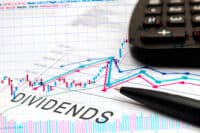
Of the equities that make up the S&P 500, only seven have market caps larger than $200 billion and pay a dividend yield of at least 3%. If you include stocks not among the S&P 500, the list expands to eight. Finally, if you look at only those stocks that have an average analyst rating of Buy or better, the list drops to four.
With 10-year Treasury notes yielding about 1.5% and 30-year notes yielding about 2.2%, investing in these four may be an alternative for people seeking a safe investment offering a better return. If you’re looking for any even safer choice, three of the four stocks are Dividend Aristocrats, indicating that they have raised (not just paid) dividends for 25 consecutive years.
[in-text-ad]
AbbVie
AbbVie Inc. (NYSE: ABBV) is one of two drugmakers on this list of four top dividend stocks. The company’s market cap is about $205 billion, and its dividend yield is 4.47%. AbbVie is among the 65 Dividend Aristocrats and has a median analysts’ recommendation of 2.0 — on a scale of 1 (Strong Buy) to 5 (Strong Sell). That is a solid Buy rating. The company’s one-year total return is 24.74%.
The company’s forward price-to-earnings (P/E) ratio is 9.35, compared with a sector average of around 27 and an industry average of 19.6. Even with that wide gap, AbbVie shares are widely estimated to be overvalued, due in large part to the company’s P/E ratio for the trailing 12 months of more than 43. The stock trades with a potential upside of about 7.6%, based on a current price of $115.10 and a 12-month price target of $123.82.
AbbVie’s strengths are its projected year-over-year 19% increase in earnings per share and 22% jump in revenue. That lush dividend appears safe for at least another year and, if history is any guide, for some time to come.
Chevron
Energy supermajor Chevron Corp. (NYSE: CVX) has a market cap of about $207.4 billion and, in addition to paying a dividend yield of 4.94%, is listed among the Dividend Aristocrats. However, the oil and gas giant has a median analysts’ recommendation of 2.3, the lowest among the four stocks in this group. Chevron’s total one-year return is 17.06%.
Chevron’s P/E ratio of 16.67 is only slightly above the sector average of 16.23. The company’s stock is also the most heavily traded of the four stocks in the group, with a daily average of more than 9.7 million shares traded. At a price of about $108.10, the upside potential based on a price target of $120.71 is 11.7%.
Chevron shareholders sent the company a strong message late last month that they expect larger emissions cuts, not just in its use of carbon-emitting fuels, but in the carbon emitted from burning its oil and gas products as well. These cuts are usually referred to as Scope 3 and have been adopted (sometimes following strong shareholder and regulatory persuasion) by some European energy giants.
[in-text-ad]
Coca-Cola
The largest of the four is Coca-Cola Co. (NYSE: KO), with a market cap of around $238.5 billion. It is also a Dividend Aristocrat and pays a dividend yield of 3%. The analysts’ mean recommendation for the stock is 1.6, making it a solid buying choice. The company’s total return for the past 12 months is 18.75%.
Coca-Cola’s forward P/E ratio is 23.75, slightly higher than the sector average of around 21.8. That indicates that the stock may be somewhat overvalued. Is that a threat to the company’s dividend payments? Not soon, for sure.
Warren Buffett’s Berkshire Hathaway owns 400 million shares of Coca-Cola stock (about 9.3% of shares outstanding) and is the company’s largest shareholder. Buffett first bought Coke stock in 1988 and has never sold a single share.
Novartis
Switzerland-based drugmaker Novartis A.G. (NYSE: NVS) is the only one of these four stocks that is not included on the S&P 500, and one of two that is not listed among the 65 Dividend Aristocrats. The company’s market cap is around $223.2 billion, and Novartis pays a dividend yield of 3.42%. Analysts’ mean recommendation on the stock is 1.7, another solid buying selection. The company’s total return for the past 12 months is 8.00%.
The company’s forward P/E ratio is 14.1, compared with a sector average of around 27 and an industry average of 19.6. At a price of around $92.70 and with a mean target price of about $105.10, the upside potential on the stock is about 14.4%. Novartis’s share price has increased by less than 1% so far this year, and at one point in mid-March, shares traded down by almost 10%.
Last week Novartis sued the U.S. Department of Health and Human Services, seeking to end the department’s imposition of a penalty related to a drug-pricing program. There are not huge sums involved, but the company’s actions indicate a willingness to contest even small monetary penalties.
Get Ready To Retire (Sponsored)
Start by taking a quick retirement quiz from SmartAsset that will match you with up to 3 financial advisors that serve your area and beyond in 5 minutes, or less.
Each advisor has been vetted by SmartAsset and is held to a fiduciary standard to act in your best interests.
Here’s how it works:
1. Answer SmartAsset advisor match quiz
2. Review your pre-screened matches at your leisure. Check out the advisors’ profiles.
3. Speak with advisors at no cost to you. Have an introductory call on the phone or introduction in person and choose whom to work with in the future
Thank you for reading! Have some feedback for us?
Contact the 24/7 Wall St. editorial team.

 24/7 Wall St.
24/7 Wall St.



